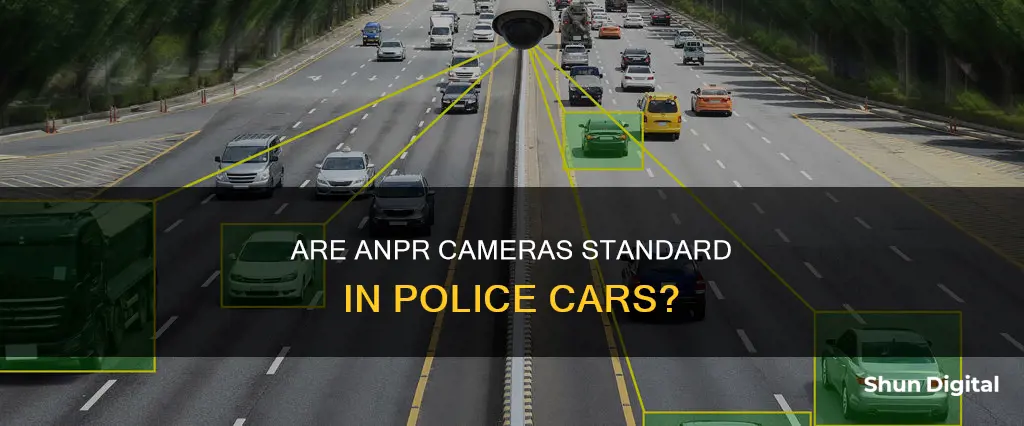
ANPR stands for Automatic Number Plate Recognition. ANPR cameras are used by police to read vehicle registration plates, which are then used alongside location data for traffic and law enforcement purposes. While ANPR cameras are commonly found across the UK, not all police vehicles are mounted with an ANPR camera. The North Yorkshire Police, for example, has invested in ANPR technology, including in-car cameras, to tackle travelling criminals.
| Characteristics | Values |
|---|---|
| What does ANPR stand for? | Automatic Number Plate Recognition |
| Who uses ANPR technology? | Law Enforcement Agencies (LEAs) including the police, private companies, local authorities, the DVSA and the DVLA |
| How do police use ANPR technology? | To help detect, deter and disrupt criminality at a local, force, regional and national level, including tackling travelling criminals, Organised Crime Groups and terrorists |
| Do all police cars have ANPR? | No, not every police vehicle is mounted with an ANPR camera. Exact figures of how many police vehicles have ANPR systems installed are not readily available for all regions |
| What can ANPR cameras be used for? | Detecting uninsured vehicles, locating stolen vehicles, solving cases of terrorism, major and organised crime, checking for parking violations, and tracking the number of available parking spaces |
| Where are ANPR cameras located? | In some police vehicles, at fixed locations, in car parks, on motorways and trunk roads, and at sites that require a high level of security such as prisons and private warehouses |
| How many ANPR cameras are there in the UK? | Around 11,000 |
| How long is ANPR data stored for? | Up to one year, although police staff usually only have access to data relevant to their role for 90 days from the date it was collected |
What You'll Learn

Not all police cars have ANPR cameras
While ANPR cameras are an important tool for law enforcement, it is not standard equipment in all police vehicles. The exact number of police cars equipped with ANPR cameras varies by region and is not readily available for all areas. However, some police forces disclose this information on their websites or through other sources.
The presence of ANPR cameras in police cars enhances their ability to identify vehicles of interest. For example, police vehicles with ANPR cameras can recognise cars driving in the adjacent lane or in the opposite direction, up to speeds of 250 km/h. This enables officers to instantly check for stolen vehicles, invalid registrations, or any other violations.
Additionally, ANPR cameras can be used to identify parked vehicles in car parks or on the street. This technology assists officers in checking for parking violations and validating parking payments. The ability to recognise license plates in real time and compare them against police databases makes ANPR a valuable tool for law enforcement.
Although not all police cars are equipped with ANPR cameras, the technology is still extensively used by police forces. ANPR cameras are employed at fixed locations, on mobile safety cameras, and in-car installations to detect and disrupt criminal behaviour. The intelligence gathered from ANPR systems helps police forces proactively target and intercept criminals.
The Yashica YK Camera: A Historical Timeline
You may want to see also

ANPR data is stored for a maximum of one year
Automatic Number Plate Recognition (ANPR) is a technology that uses optical character recognition on images to read vehicle registration plates and create vehicle location data. ANPR is used by police forces around the world to check if a vehicle is registered or licensed, for electronic toll collection, and to catalogue the movements of traffic. ANPR cameras are used in police cars, at fixed locations, and on roads and motorways.
The retention period for ANPR data may vary depending on the country and the specific laws and regulations in place. For example, in the United Kingdom, the Home Office states that the purpose of ANPR is to help detect, deter, and disrupt criminality, including tackling organised crime groups and terrorists. Vehicle movements are recorded through a network of nearly 13,000 cameras, capturing approximately 55 million ANPR 'read' records daily. These records are stored for up to two years in the National ANPR Data Centre, which can be accessed and analysed by UK law enforcement agencies.
In the United States, the retention of ANPR data varies by state. As of 2019, 16 states have limits on how long the data may be retained, with the lowest being New Hampshire (3 minutes) and the highest being Colorado (3 years). The Supreme Court of Virginia initially ruled in 2018 that data collected from ANPRs constitutes personal information. However, this decision was overturned in 2020, and it was determined that the data collected was not personal or identifying information.
It is important to note that the retention and usage of ANPR data are subject to applicable laws and regulations, and there may be differences in the specific practices of law enforcement agencies in different jurisdictions.
The Power of Wyze Cameras: Battery or Plug-in?
You may want to see also

ANPR cameras are used to detect uninsured vehicles
ANPR cameras, or Automatic Number Plate Recognition devices, are used to detect uninsured vehicles. They are a type of mass surveillance device that can read vehicle number plates and link this information to specific location data. This technology is used by law enforcement agencies, including the police, as well as private companies, local authorities, and government bodies such as the DVSA and DVLA.
ANPR cameras are an effective tool for detecting and deterring criminal activity, including locating stolen vehicles, identifying uninsured vehicles, and solving cases of terrorism, major crime, and organised crime. The cameras can be mounted on police vehicles, but they are also placed at fixed locations such as motorways, main roads, and car parks.
The use of ANPR cameras allows for a rapid response from law enforcement. When a vehicle passes an ANPR camera, its registration number is instantly checked against a database of "vehicles of interest". If a match is found, police officers can intercept the vehicle, check it for evidence, and make arrests if necessary.
The data collected by ANPR cameras includes the Vehicle Registration Mark (VRM) and camera identification, and it is shared with relevant law enforcement agencies. This data is typically accessible to authorised staff members for a period of 90 days to one year, depending on the ongoing investigations.
In addition to detecting uninsured vehicles, ANPR cameras can also be used for traffic management and enforcement. They can measure traffic flow, monitor congestion zones, and detect vehicles that have exceeded their paid parking allowance or left without paying. ANPR cameras are an invaluable tool for promoting safety and accountability on the roads, assisting in the detection and prevention of criminal activities, and facilitating efficient traffic management.
Simplisafe Doorbell Camera: Battery or Wired?
You may want to see also

ANPR technology is used by police and private companies
ANPR, or Automatic Number Plate Recognition, is a technology that reads vehicle registration plates to create location data. This information is captured by scanners or cameras and then cross-referenced for a range of traffic and law enforcement purposes.
ANPR technology is used by two main groups: Law Enforcement Agencies (LEAs) including the police, and private companies, local authorities, and the Department for Transport.
Police Use of ANPR Technology
The police use ANPR technology to "detect, deter and disrupt criminality". This includes detecting uninsured and untaxed vehicles, locating stolen vehicles, and solving cases of major and organised crime. ANPR can also be used to calculate the average speed of vehicles, and issue any relevant fines.
Private Company Use of ANPR Technology
Private companies use ANPR technology for car park management. This includes easier payment processes, visibility of spaces, and ticketless systems. ANPR technology can also be used at sites that require a high level of security, such as prisons and private warehouses, to grant or deny access to vehicles based on their number plates.
Connecting a Document Camera: A Step-by-Step Guide
You may want to see also

ANPR cameras can be used to calculate average vehicle speed
ANPR cameras, or Automatic Number Plate Recognition cameras, are an effective tool for monitoring and enforcing speed limits. These cameras are strategically placed at separate locations along a stretch of road, capturing images of vehicle number plates and recording timestamps. By calculating the time it takes for a vehicle to travel between two points, the system can determine the average speed. This information is then used to flag vehicles that exceed the speed limit, leading to potential speeding violations.
The use of ANPR cameras for speed enforcement offers several advantages. Firstly, it promotes safer driving conditions by deterring speeding and encouraging consistent speed compliance. Secondly, it provides fairer enforcement by considering the overall speed of a vehicle over a distance, rather than a single point in time. This results in a more accurate reflection of a driver's behaviour. Additionally, the presence of these cameras raises drivers' awareness about obeying speed limits and fosters more responsible driving habits.
The effectiveness of ANPR cameras in reducing speeding incidents and crash rates has been validated by statistical evidence. Studies have shown a significant decrease in crashes, ranging from 8% to 49%, in areas with speed camera zones. The reduction in fatalities and serious injuries further highlights the positive impact of these systems on road safety.
However, it's important to acknowledge that not all police cars are equipped with ANPR cameras. While they are widely used by law enforcement agencies, the exact figures for the number of police vehicles with ANPR systems installed vary across different regions and may not be readily available to the public.
In conclusion, ANPR cameras play a crucial role in maintaining road safety and promoting responsible driving. By calculating average vehicle speed, these systems provide a robust mechanism for sustained speed control, ultimately reducing the frequency and severity of collisions.
Can TV Be Gone Remote Block Surveillance Cameras?
You may want to see also
Frequently asked questions
No, not all police cars have ANPR cameras. The exact number of police vehicles with ANPR systems is not publicly available, but some police forces disclose this information on their websites.
ANPR stands for Automatic Number Plate Recognition. ANPR cameras read vehicle registration plates and use location data for various traffic and law enforcement purposes.
ANPR technology helps police detect, deter, and disrupt criminal activity, including locating stolen vehicles, tackling uninsured drivers, and solving cases of terrorism, major crime, and organised crime.







